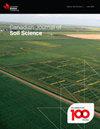生物炭的应用稳定了煤矿土壤中的重金属
IF 1.5
4区 农林科学
Q4 SOIL SCIENCE
引用次数: 1
摘要
摘要:煤矿开采废弃物对植物有害元素在土壤中积累。生物炭被认为是稳定重金属的重要土壤修复策略。本研究的目的是量化生物炭来源和速率对煤污染土壤重金属稳定化的影响。将玉米秸秆(MBC)、水稻秸秆(RBC)和甘蔗渣(SBC)三种原料(0%、0.5%、1%和2%,即0、10、20和40 ton ha - 1)的生物炭分别施用于两种土壤(自然污染土壤(NCS)和添加Cd、Cu、Cr和Pb的人工污染土壤(ACS))。在25℃条件下,以30%田间容量培养90 d,分别于1、4、8、12周后测定土壤pH、电导率(EC)和重金属浓度。在生物炭中,与MBC和SBC相比,RBC对Cd、Pb、Cu和Cr的固定化效果最好。同样,施用生物炭增加了重度固定化,与对照相比,最大固定化率为2%(40吨公顷- 1)。与对照相比,添加生物炭的土壤pH值均有所增加。随着时间的推移,生物炭对重金属稳定的修复效果是积极的。较高的速率(40吨ha - 1) RBC用于ACS和MBC用于NCS可以有效地用于重金属稳定。本文章由计算机程序翻译,如有差异,请以英文原文为准。
Biochar application stabilized the heavy metals in coal mined soil
Abstract The waste of coal mining activities causes accumulation of hazardous elements in soil for plants. Biochar is considered an important soil remediation strategy to stabilize the heavy metals. The aim of this study was to quantify the effect of biochar sources and rate on the heavy metal stabilization in coal-contaminated soil. Biochars of three feedstocks (maize straw (MBC), rice straw (RBC), and sugarcane bagasse (SBC)) with four levels (0%, 0.5%, 1%, and 2%, i.e., 0, 10, 20, and 40 ton ha−1) were applied to two types of soils (naturally contaminated soil (NCS) versus artificially contaminated soil (ACS) spiked with Cd, Cu, Cr, and Pb). Plastic pots were incubated at 30% field capacity for 90 days at 25 °C, and soil pH, electrical conductivity (EC), and heavy metals concentration were measured after 1, 4, 8, and 12 weeks. Among the biochars, RBC showed maximum immobilization of Cd, Pb, Cu, and Cr as compared with MBC and SBC. Similarly, biochar application increased heavy immobilization, being maximum at 2% (40 ton ha−1) rate compared with control. The pH of both soils with biochar addition increased as compared with control. The remediation effect of biochar on heavy metal stabilization was positive over time. The higher rate (40 ton ha−1) of RBC for ACS and MBC for NCS could be used effectively for heavy metal stabilization.
求助全文
通过发布文献求助,成功后即可免费获取论文全文。
去求助
来源期刊

Canadian Journal of Soil Science
农林科学-土壤科学
CiteScore
2.90
自引率
11.80%
发文量
73
审稿时长
6.0 months
期刊介绍:
The Canadian Journal of Soil Science is an international peer-reviewed journal published in cooperation with the Canadian Society of Soil Science. The journal publishes original research on the use, management, structure and development of soils and draws from the disciplines of soil science, agrometeorology, ecology, agricultural engineering, environmental science, hydrology, forestry, geology, geography and climatology. Research is published in a number of topic sections including: agrometeorology; ecology, biological processes and plant interactions; composition and chemical processes; physical processes and interfaces; genesis, landscape processes and relationships; contamination and environmental stewardship; and management for agricultural, forestry and urban uses.
 求助内容:
求助内容: 应助结果提醒方式:
应助结果提醒方式:


